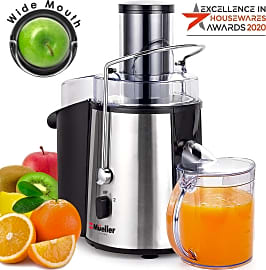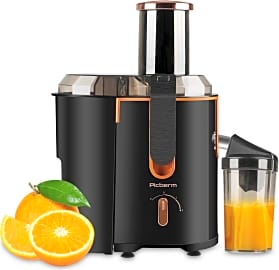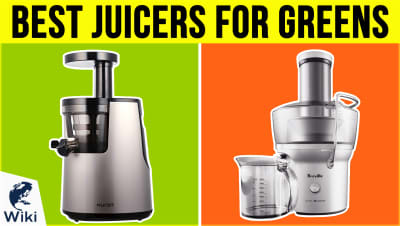The 10 Best Centrifugal Juicers

This wiki has been updated 39 times since it was first published in April of 2015. If you enjoy fresh flavor and the nourishing goodness of green smoothies, or are just looking for creative ways to sneak more fruit and vegetables into picky youngsters' diets, you'll get plenty of use out of one of these centrifugal juicers. Using ultra-fine mesh strainers and high RPM, they make short work of extracting all the healthy nutrients from your favorite produce. When users buy our independently chosen editorial choices, we may earn commissions to help fund the Wiki.
Editor's Notes
May 06, 2020:
During this round of updates, while we removed the Jack LaLanne power Express, Breville Compact Juice Fountain Jamba, Super Chut and Breville Juice Fountain Duo due to availability issues, we also made several new additions to our rankings including the Koios JE-70 – a model with all-copper motor windings that are protected by warranty for 10 years, the Picberm PB2312A – which can turn at an impressive speed of 20,000 rotations per minute, and the Mueller Austria Ultra – a stainless-steel option that can produce a 16-ounce cup of juice in just eight seconds.
A few things to think about for this category:
Centrifugal vs. Masticating: There’s no doubt that a juicer can make a fantastic addition to your kitchen, but picking your first one can be quite intimidating – especially with all the proponents of these appliances talking about them like they’re a lifestyle choice. If you’re not sure where to begin with this decision, a decent place to start is deciding whether you’re interested in a centrifugal juicer, like the ones ranked on this page, or a masticating juicer.
Masticating juicers are widely considered to be a better choice for juicing things like leafy greens and wheatgrass, but they also tend to be much slower and more labor intensive – since they tend to require more chopping. Masticating juicers are also known to generate less heat, which allows you to retain more of your juice’s nutrients, but there are centrifugal models that actively address this concern. The Breville Fountain Elite, for instance, allows a modest maximum heat transfer of 1.8 Fahrenheit.
If you’re leaning against purchasing a centrifugal juicer, we also maintain a separate set of rankings for masticating juicers. And, if there’s a sort of produce you know that you’re primarily interested in processing, we also have rankings for wheatgrass juicers, citrus juicers and juicers for greens.
Clean Up: This is the part of the juicing process that’s known to really put people off the practice. While many users find preparation to be pleasurable, and the tasty concoction they come up with to be a delight, oftentimes the mess generated by these machines is thought to be too much to justify regular use.
With that in mind, many manufacturers have included design provisions to help mitigate the mess. Several of our selections – including the Picberm PB2312A and Breville Fountain Elite – feature dishwasher-safe parts. The Picberm PB2312A, like the Mueller Austria Ultra, is also an example of a model with slip-resistant feet that do a good job gripping the countertop to prevent the unit from vibrating all over the place during operation. The Hamilton Beach Easy Clean and Koios JE-70 both come with specialized tools to help with clean up, and the Vevor Extractor Machine and Picberm PB2312A have adjustable spouts to help reduce drippage.
Power Rating: A given juicer’s watt rating is one metric you can look at to try to get a grip on what sort of performance you can expect from it. In other cases, companies will provide you with speed ratings expressed in rotations per minute, which likely reflect their motors no-load speeds. Using examples provided by the manufacturers, you can see the difference between a slower unit like the Vevor Extractor Machine – which has a 370-watt rating, runs at speeds of 2,800 rotations per minute and produces up to 26 ounces of juice in one minute – and a faster model like the Mueller Austria Ultra – which has a 1,100-watt rating, runs at speeds up to 18,000 rotations per minute and produces up to 120 ounces of juice in one minute.
Why You Need To Start Juicing
Or maybe you’ll keep going to McDonald’s, but you’ll start getting salad more often.
If you’re like most of us, eating healthily must not seem like the easiest thing to do. We’re inundated on a daily basis by temptation and rationalization, encouraging us to make bad decisions and giving us just enough hope that we can just start our recovery tomorrow. Often, these recoveries from foods that harm our bodies are little more than tricks peddled by the same manufacturer to keep us on the hook.
Maybe you’ll take a few weeks off from drinking regular Coke and switch to Diet. Well, it turns out, Diet’s not that much better for you, and if you’re concerned about more than just your waistline (i.e. your lifespan), it may even be worse. Or maybe you’ll keep going to McDonald’s, but you’ll start getting salad more often. That sounds healthy, right? Unfortunately, the inorganic, irradiated vegetables that comprise most fast food salads are going to wreak havoc on your insides, even if they come at a lower caloric cost.
The benefit of a can of soda or a happy meal is merely that it's convenient, that it can be ready for you in very little time. Many people also seem to enjoy the flavors that these foods provide. Fortunately, if you want to really make a positive change in the name of your health and wellness — and that of your family — you can turn to the convenient and delicious joy of juicing.
I know you're thinking that juicing is this incredibly difficult process that involves a ton of work and yields little more than a small amount of bitter, undrinkable swill. While there might have been a time when that was mostly true, today’s juicers and juice recipes are extremely easy to concoct, and they taste incredible.
More importantly, however, is just how good juicing is for your body. In a single session, you stand to get your hands on all the vitamins and micro nutrients that a day’s servings of fruits or vegetables would otherwise provide. That means you can spend less time worrying about your nutrient intake and more time enjoying your day.
Centrifugal Vs. Other Options
If you’re in the market for a juicer, there’s a good chance that you haven’t quite decided which type of juicer is right for you. There are some hard truths about each kind of juicer that are worth facing, some of which may lead you to purchasing more than one kind in the near future.
The centrifugal juicer works by spinning a basket-like blade that effectively shreds a fruit or vegetable, and separates its fibrous material (the pulp) from its internal water and a large amount of its nutritional content (the juice). The juice then pours out of a dedicated spout into a waiting receptacle, while the pulp is ejected into a bin for another use or simply for disposal.
If you’re in the market for a juicer, there’s a good chance that you haven’t quite decided which type of juicer is right for you.
There are some downsides to centrifugal juicing, but it tends to be the fastest and the cheapest method. If you’re just starting out on your juicing journey, the centrifugal juicer is often the best place to begin, since you won’t have to spend a tremendous amount of money on it, and since the process will be relatively painless. For example, many centrifugal juicers have very large openings that allow you to feed fruits and vegetables into them with little to no prep work. Most also have parts that are dishwasher-safe, making cleanup a breeze.
On the negative side, centrifugal juicers create an ionizing effect that speeds up oxidation, rendering some potentially beneficial enzymes dead on arrival. You also have to drink this kind of juice right away, as that oxidation continues at a rapid pace from the moment the beverage is ready.
Some other juicers you may have seen include masticating juicers and high quality blenders that claim to produce a juice without removing any of the fiber. In the case of masticating juicers, fruits and veggies are slowly pressed and ground to release their juices. This process often gets a little more juice out of a given ingredient, and it does so without ionizing away any enzymes. Unfortunately, many masticating juicers are prohibitively expensive, and most are a pain in the neck to clean.
Those high-quality blenders are pretty spectacular when you consider the wide breadth of tasks they can accomplish, but their juicing is lackluster at best. More often than not, the juices they produce are on the thick and bitter side, thanks largely to the fact that they keep all that pulp. These, too, are often very expensive.
Ultimately, you might end up owning one of each type for different tasks, but you’re more likely to enjoy the process from start to finish (including the juice that you actually have to drink) with a centrifugal juicer.
How To Make Juicing Even Easier
If you plan to juice on a regular basis, it’d be a good idea to give yourself every advantage to stay on top of your habit. The following tips will help ensure that you use your juicer every day.
Don’t cut more than you have to here, however, as exposing certain fruits and veggies like that can cause unwanted oxidation and make your juices a little less potent.
Prepare whatever you can in advance. As you get to know your juicer, you’ll also get to know what recipes you like the most. With those in mind, you can spend a Sunday evening washing and preparing the portions of produce you want to use for each day of the week to come. Don’t cut more than you have to here, however, as exposing certain fruits and veggies like that can cause unwanted oxidation and make your juices a little less potent.
The majority of centrifugal juicers eject their pulp material into a basin located at the back or side of the unit. You’ll see a lot of great ideas for what you can do not to waste this pulp material all over the internet, from composting to baking muffins. The sooner you come to terms with the fact that you’re probably not going to do much with the pulp, the better. Then, you can simply fill that catch basin with a small plastic shopping bag, and make it incredibly easy to discard without having to clean out that part of the juicer after every use.















